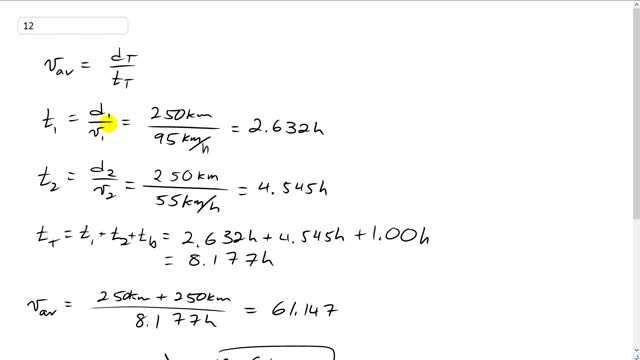
Calculate the average speed and average velocity of a complete round trip in which the outgoing 250 km is covered at 95 km/h, followed by a 1.0-h lunch break, and the return 250 km is covered at 55 km/h.
- 0 since no displacement

In order to watch this solution you need to have a subscription.
This is Giancoli Answers with Mr. Dychko. Average speed is calculated by taking the total distance traveled divided by the total time it takes to travel that distance. So we need to know how long we spent on the outward trip which is 250 kilometers divided by 95 kilometers per hour that gives 2.632 hours going on the outbound trip and then there's a break for 1 hour and that's no calculation needed there— t subscript b for break— and the t 2—the amount of time to come back— is gonna be the same 250 kilometers but now it's divided by 55 kilometers an hour, different speed, that gives 4.545 hours and so we add up all these times and we get 8.177 hours is the total time spent on this trip including the break and we get total distance—500 kilometers— divided by the total time which is 61.147; we'll round that to two significant figures, 61 kilometers per hour is the average speed. The average velocity is zero because the final position is the same as the initial position and so there's no displacement and so there's no average velocity.
So, first off, I have to say that I love this site so far. I am kind of struggling with the issues that arise from rounding errors. I am familiar with significant figures, but I am wondering if there is a better rule of thumb. Normally I don't round until I get the final answer, but I got problem #7 wrong. On this problem, I did all of the steps correctly, but I rounded up the times t1 and t2 to 2 sig figs and ended up getting 62 km/h. Is there anything I should know that might be helpful as I prepare for tests and future problem sets?
Thanks!
Hi brysongrondel, thank you very much for the nice feedback, and your question. The general idea is to avoid rounding until the final answer. Rounding values before a final answer is called intermediate rounding error, and causes the final answer to differ as a result of the rounding. So, generally, avoid rounding until the end. It's a topic that calls for a bit of patience since most numbers need rounding eventually, and the answer you're comparing to may have chosen a different number of digits than you, resulting in a different answer than what you obtained despite your following the best practice of keeping "lots" of digits until the end. Different people could have different opinions on what "lots" means. I would say that two additional digits, beyond those that are significant , should be kept with intermediate numbers.
Hope that helps,
Mr. Dychko